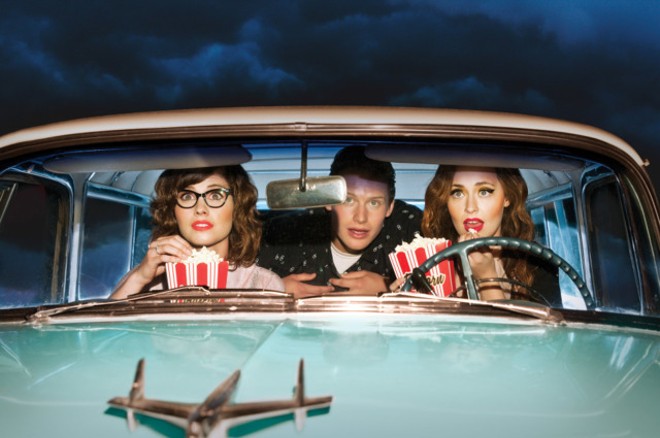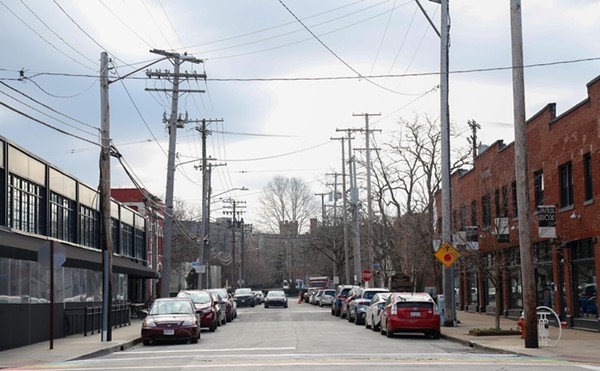More Ohio Moviegoers Are Enjoying a Night at the Drive-In Because of COVID-19
By Maria McGinnis, Ohio News Connection on Fri, Jul 10, 2020 at 2:24 pm
[
{
"name": "Ad - NativeInline - Injected",
"component": "38482495",
"insertPoint": "3",
"requiredCountToDisplay": "5"
},{
"name": "Real 1 Player (r2) - Inline",
"component": "38482494",
"insertPoint": "2/3",
"requiredCountToDisplay": "9"
}
]
It's a warm summer night at the movies. This year, with the majority of indoor theaters in Ohio still closed because of COVID-19, lines of cars form outside the ticket booths of drive-in theaters instead.
After getting their tickets, drivers pull their cars slowly into the lot marked with poles indicating where to park. Moviegoers then tune their car radios to the right station to hear the old blockbuster feature that night. They listen to ads for the concession stand, where people can wait in line — six feet apart — for their popcorn and snacks. When the sun finally starts to go down, headlights turn off and the movie begins.
As co-owner of the Holiday Auto Theatre in Hamilton, Ohio, Mark Althoetmar has seen an increase in weekday business and first-time guests at the drive-in.
The movie theater industry in general had been dwindling before the pandemic, especially with the increase in streaming services. But now, in a time when social distancing is a top priority, drive-ins are experiencing a resurgence.
"We've seen high school graduations, we've seen weddings," said Nick Hensgen, the owner/operator of driveinmovie.com, a database of all the drive-in theaters currently in operation, worldwide. "Not only are they showing movies now, but several of them have found other ways, other sources of revenue, to help get by until movies start coming out again — which will be later this summer, hopefully."
The first drive-in movie theater opened in 1933 in Camden, New Jersey. By the late 1950s to early 1960s, the number of drive-in theaters in the United States exploded, with more than 4,000 drive-ins opening from coast to coast.
But this "golden age" of drive-ins lasted only about a decade. Most were built in more rural areas, and as urban sprawl continued in the 1970s, it became more profitable to sell the land than operate a drive-in on it, Hensgen explained.
In addition, he said, the implementation of daylight saving time in the summer pushed the drive-in movie start times back by an hour.
"I live in Louisville, Kentucky," Hensgen said. "We're in the very western part of the Eastern time zone. So, during the peak summer, drive-ins around here don't start until 10 p.m. So it's late, especially on weeknights when people have to work. And there's so many entertainment options; it kind of started way back to the '70s and '80s with VHS tapes. But, of course, now we have streaming — just so many in-home entertainment options that folks have now. It's not just drive-ins; the number of indoor theaters has also been decreasing the last several years."
Drive-ins continued to close throughout the 1980s and 1990s. But in the late '90s to early 2000s, the drive-in theater industry experienced a minor comeback as previously closed theaters were renovated and reopened, and some new ones emerged as well.
Then, when the movie industry began using digital cinematography rather than film in the 2000s, some small, rural theaters were forced to close because they couldn't afford the new digital projectors, costing anywhere from $50,000 to $250,000.
Despite the challenges, there are 305 functioning drive-in theaters in the U.S, according to United Drive-in Theatre Owner Association (UDITOA) figures from October 2019. Ohio is home to 24 of them, making it the third-largest state for drive-ins behind New York and Pennsylvania.
"Drive-ins are kind of made for social distancing," Hensgen said. "A lot of these (drive-ins) have gone to online ticket sales, online concession ordering. So, you could literally go to the drive-in and stay in your car the entire time, if that's what you want to do. And inside your car is an environment you can control, versus going to an indoor movie theater — you don't know who's been there, who might be positive for COVID and things like that. But when you're in your car, you can control that environment."
Businesses across the board that have reopened in the pandemic are implementing new policies to keep employees and customers safe, and drive-in theaters are no exception.
At the Skyway Twin Drive-in Theatre in Warren, Ohio, owner Brian DeCiancio said they are enforcing a six-feet-between-vehicles rule, as well as having people order and pick up concessions at windows, since the customers are not allowed inside.
Althoetmar said the Holiday Auto Theatre has also made changes to keep customers and staff safe. He said they've always offered online ticket sales, and have seen an increase — because purchasing tickets beforehand guarantees a spot at the drive-in.
Social distancing markers have been added to the concession stand and restrooms to keep customers at a safe distance, as well as Plexiglas barriers separating customers and employees in the concession area.
Althoetmar added that doorknobs are also regularly sanitized along with general, extensive cleaning at the theater. All employees wear masks and patrons are welcome to either stay inside their cars, or sit outside of them, to watch the movies.
Some drive-ins also host events other than movies. DeCiancio said the Skyway Twin Drive-in Theatre has hosted six graduations, a dance studio recital and is planning other special occasions, as well.
Hensgen said drive-ins are also turning out to be good venues for concerts. Country music artist Garth Brooks performed live on June 27 in Nashville, Tennessee, and the concert was shown on screens at 300 drive-ins in the U.S. Tickets cost $100 per vehicle.
Some people will stay home and stream their entertainment; others will go to indoor theaters as they reopen. The big screen and sound system of the indoor movie experience is an immersive way to enjoy a show without household interruptions. Still, Althoetmar said, the drive-in offers a unique experience that can't be duplicated — at home or indoors.
"Going to a drive-in is not only experiencing a movie on a large screen, but also a social experience," he said. "It's almost more like going to a theme park in a lot of ways. It's not just about the movie, but it's sitting outside, watching the sunset and seeing a film under the stars in lawn chairs. During the trip to the concession stand, one may see friends and neighbors. Drive-ins offer entertainment and a sense of community."
The sheer uniqueness of the experience leads Althoetmar to believe the industry won't see much of a decline, although he acknowledged that it depends on what the companies producing and releasing films decide to do.
In the past, when a movie was released, it would not be available on streaming platforms for several months. Now, that window has shrunk — it can be anywhere from 45 days to two months. This has long been a source of contention between theater owners and film companies, as theaters like having an exclusive window of time to show movies before they are more widely available.
Althoetmar said he doesn't think this will affect drive-ins, however.
"People do want to just get out of the house right now," he said. "So, even though there's not a big movie that's been released, people are coming out to the drive-in. That could be something that might be unique to COVID-19, is that people are willing just to go out to see a movie, no matter what movie it is."
Hensgen agrees that drive-ins can survive financially this season, even if they only show retro films or older movies released before the pandemic.
"I do think it's possible," he said. "Now, one of the reasons they're selling out is, most drive-ins are operating at 50% capacity because they're leaving a space between cars. But so far, most of these drive-ins appear to be having no problem filling up."
DeCiancio said drive-ins are at the mercy of the movie studios for new fare, as new releases aren't likely to happen until many more indoor theaters have reopened. He said there simply aren't enough drive-ins for film studios to justify putting new movies out at this time.
Althoetmar's Holiday Auto Theatre is going to continue to show retro movies, with new releases as the studios provide them. AMC Theaters, the world's largest theater owner, plans to reopen all its theaters in July — bringing good news to drive-in owners.
"Disney pushed back Mulan, which was the very first, big movie of the summer season," Althoetmar said. "So, we're looking forward to that hitting the screen and having a new movie. After that, I think there will be other films that start to get released. I think they're all just taking it week by week, maybe throwing something out there, and then seeing how it works."
The drive-in theater pioneers of the 1950s probably could not have predicted that this form of entertainment would go out of style — or that a health crisis would prompt its surprise resurgence some seven decades later. Drive-ins may be seen as a novelty, but these businesses operate in their own unique niche in the entertainment world.
"Over the next decade, we may lose a couple more, but I think the majority of the ones that are around today are still going to be around," Hensgen said. "Most of them don't have competition from other drive-ins. Of course, they have competition from other entertainment options — indoor movie theaters, streaming services. But most drive-ins that are still around, there's a lot of them where there's not another drive-in for hundreds of miles."
SCENE Supporters make it possible to tell the Cleveland stories you won’t find elsewhere.
Become a supporter today.
Scroll to read more Cleveland News articles
Newsletters
Join Cleveland Scene Newsletters
Subscribe now to get the latest news delivered right to your inbox.














